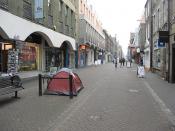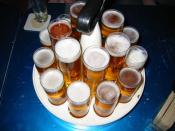The good news: despite newspaper articles, TV shows, and special interest groups, binge drinking among young people is declining steadily and has been doing so for many years. Binge drinking, according to the Higher Education Center, is defined as having five or more drinks in a row if you are a male, and for women, having four or more drinks in a row. This type of extensive drinking has dropped from 41.2% to 31.3% between 1980 and 1997 among high school seniors. College binge drinking has recently reached the lowest level of the entire 17 year period that the Institute for Social Research has been conducting these surveys.
The bad news: while the act of binge drinking is decreasing, those who take part in this act deny they are part of the statistics. Out of 12 high school seniors interviewed in the New York area, 8 said they are not binge drinkers, while they admitted to drinking, on an average, 8-10 drinks in one night.
When ask to define "binge drinking," one 17 year old girl replied, "Just drinking for fun, to have a good time, would be binge drinking. Probably about 8 or so drinks." The Higher Education Center reported that only two-tenths of one percent of the binge drinkers interviewed classified themselves as a "problem drinker." Both men and women seemed to have the same types of problems while intoxicated, with the two exceptions that men reported causing more property damage and got in trouble with the police more often. 42% of female binge drinkers and 45% of male binge drinkers reported as to missing a class, while 31% of females and 34% of males got behind in school work. 14% of females and 17% of males admitted to getting hurt or injured while under the influence, and about a quarter of both genders engaged in unplanned sexual activity. Other effects of the constant consumption of alcoholic beverages included having a hangover, doing something one later regretted, arguing with friends, loss of memory, and the need for medical attention. Another alarming statistic was that among frequent binge drinkers, 62% of the men and 49% of the women said they had driven a car after drinking, while half of them confessed they had ridden in a car with a drunk driver. This made binge drinkers 10 times more likely than non-binge drinkers to drive under the influence and 16 times more likely to drive with someone who was drunk themselves. Binge drinkers were also more likely to have used other drugs. Marijuana and cigarettes were among the two top drugs used during intoxication. Other drugs included: amphetamines, LSD, chewing tobacco and other hallucinogens.
The Higher Education's national survey states that they're are several factors which predetermine a person's tendency to become a binge drinker. One of the most important factors was whether or not students were binge drinkers in high school. These people were three times more likely to have this problem in college. Race and ethnicity also seemed to play a role in this poll. White people were more than twice as likely to become binge drinkers. Students who claimed that religion did not play a very big role in their lives were also twice as likely to become binge drinkers. Members of fraternity or sororities were four times as likely to consume high numbers of drinks. Students who were active in athletics and agreed they were very important in their lives were one and half times more likely to develop this drinking problem.
Binge drinking is one of the most serious problems among teens. Out of the 17,600 students surveyed, 44% of the students were binge drinkers. 50% of the males were binges, while 39% of the woman were also. For most of these students, getting drunk was their ultimate goal.
73% of the males and 68% of the females all said that drinking to become intoxicated was an important factor to them.
As the problems of teen drinking become more aware to the public, hopefully the statistics will continue to decline.





